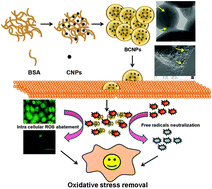Antioxidant nanozyme: a facile synthesis and evaluation of the reactive oxygen species scavenging potential of nanoceria encapsulated albumin nanoparticles†
Abstract
Several diseases and disorders, including cancer are endorsed by excessive oxidative stress caused due to the incomplete removal of reactive oxygen species (ROS) by the antioxidant defense system of the body. Therefore, present interest among the scientific community lies in the development of a highly stable, biocompatible artificial enzymatic system that possesses a high ROS scavenging activity over a period of time. In recent years, catalytic nanoparticles emerged as a potential candidate in the field of nanomedicine. Due to their inherent catalytic properties, they are exploited as an artificial enzyme (nanozyme), to reinstate or correct aberrant enzymatic activities in patients. Among them, cerium oxide nanoparticles/nanoceria (CNPs) emerged as a potent artificial redox enzyme, mimicking the activity of superoxide dismutase (SOD) and catalase and endure a tremendous ROS scavenging potential as depicted in a surfeit of human cell lines and animal models. In the present article, a facile synthesis of biocompatible nanoceria encapsulated albumin nanoparticles (BCNPs) via desolvation technique that lead to the abatement of intracellular ROS is reported. Physico-chemical characterizations of as-prepared BCNPs corroborate the formation of a highly monodispersed, spherical and stable aqueous delivery system. Interestingly, such entrapment does not affect the enzyme mimetic activity of CNPs, as demonstrated by SOD assay. The biocompatibility and ROS scavenging potential of BCNPs were further assessed in vitro against human lung epithelial cells by cell viability assay and flow cytometric analysis, respectively. The quantitative and qualitative assessments of cellular uptake of BCNPs were done by inductively coupled plasma mass spectrometry (ICP-MS), transmission electron microscopy (TEM) and field emission scanning electron microscopy (FE-SEM) analysis. Furthermore, the BCNPs preserve the cell's antioxidant defense system and protect them from oxidant-mediated apoptosis as confirmed by semi-quantitative RT-PCR analysis. Thus, the as-prepared BCNPs could provide an opportunity to be utilized as a potential candidate against ROS induced diseases and disorders.


 Please wait while we load your content...
Please wait while we load your content...